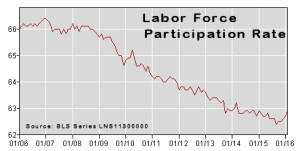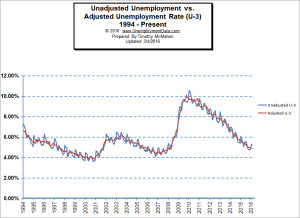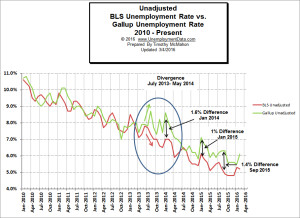February Unemployment Rate (Seasonally Adjusted)
The U.S. Bureau of Labor Statistics (BLS) released their employment data for February on Friday March 4th 2016. The commonly used seasonally adjusted U-3 Unemployment Rate was 4.9% identical to January. The BLS promotes the Seasonally Adjusted U-3 Unemployment Rate as the primary measure of unemployment. But often when we look at the adjusted Unemployment rate it is moving in the opposite direction as the unadjusted Unemployment rate. For more information see our Seasonally Adjusted vs. Unadjusted Unemployment Rate Chart.
Unadjusted Unemployment Rate and Actual Number Employed
The Un-Adjusted Unemployment Rate was down slightly from 5.3% in January to 5.2% in February. As far as actual Employment, the number of Unadjusted jobs reported for February was 142.005 million up from 141.155 million in January.
U-6 Unemployment Rate
The BLS reported that the U-6 Unemployment rate (which measures a broader range of Unemployed) was at 10.1% down from 10.5% in January. U-6 is the broadest measure of unemployment. U-6 includes all classes of Unemployed even those considered “marginally attached” and/or part-time for economic reasons. In other words, those who would like a full-time job but can only find part-time work. Unfortunately, even the U-6 does not include the “long term unemployed” i.e. those unemployed for more than a year or those on welfare who have stopped looking for a job.
Gallup Unemployment Data
You would think that no matter who collected the data, it should be relatively close, with only minor gathering differences due to collection methods, timing, etc. But that is not the case. If you compare the Unemployment numbers from the Bureau of Labor Statistics to the Gallup numbers you will find a significant difference. This month we see that Gallup is almost a full percentage point higher when it comes to the Unadjusted U-3 with Gallup at 6.1% and Gallup is 4.6% higher with their U-6 estimate at 14.7%.
Labor Force Participation Rate
As mentioned above one of the major shortcomings of the U-3 and even the U-6 measurement is that it fails to address the issue of long term unemployment. Once you have been unemployed for longer than a year you become invisible to the unemployment rate. This makes the numbers appear better even though the situation may have actually deteriorated. In February the Labor Force Participation Rate was 62.9% down significantly from 2008. This drastic drop masks the Unemployment rate and makes it look better when all that has happened is that the unemployed have moved from looking for jobs to being permanently disenfranchised.


